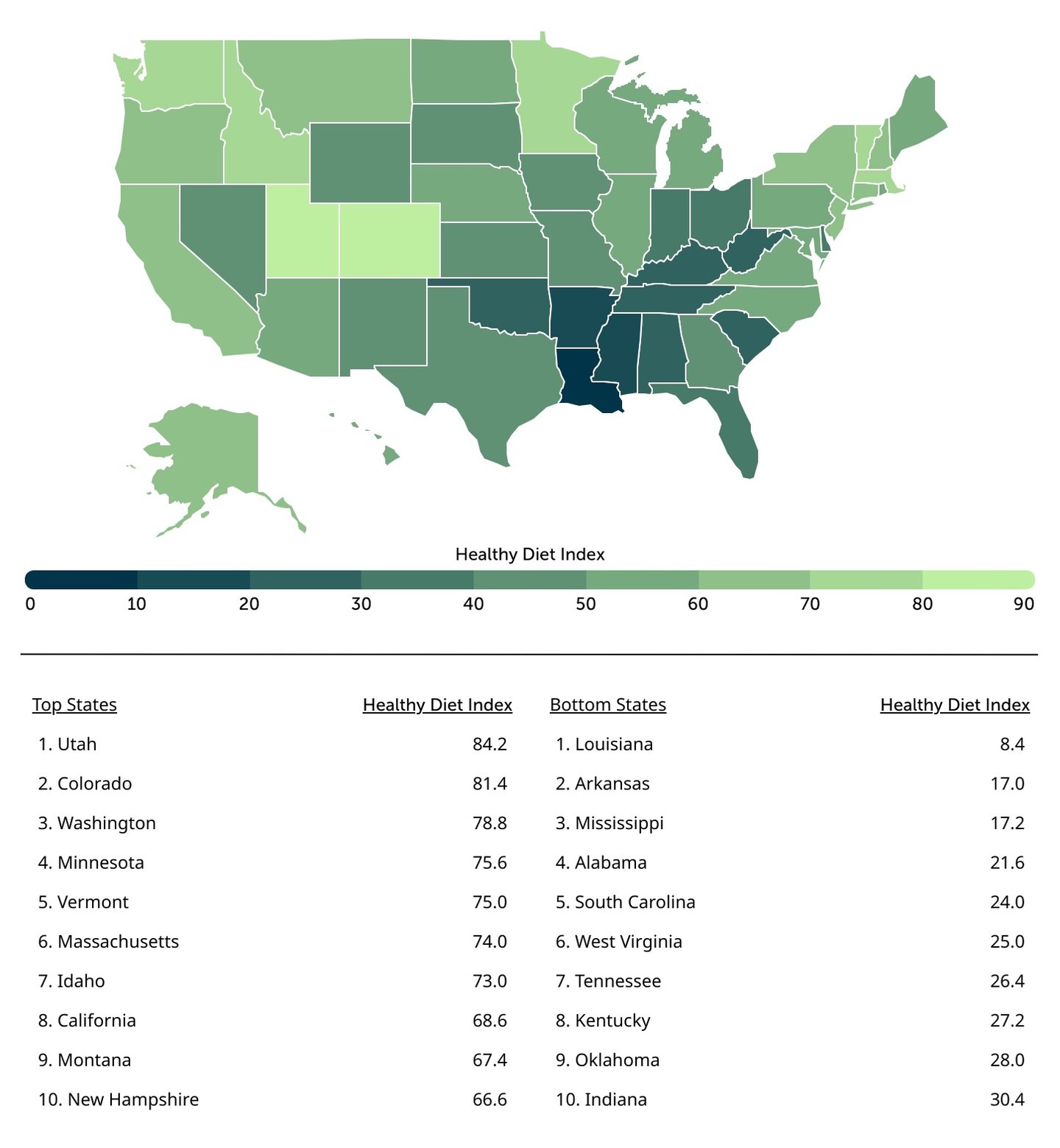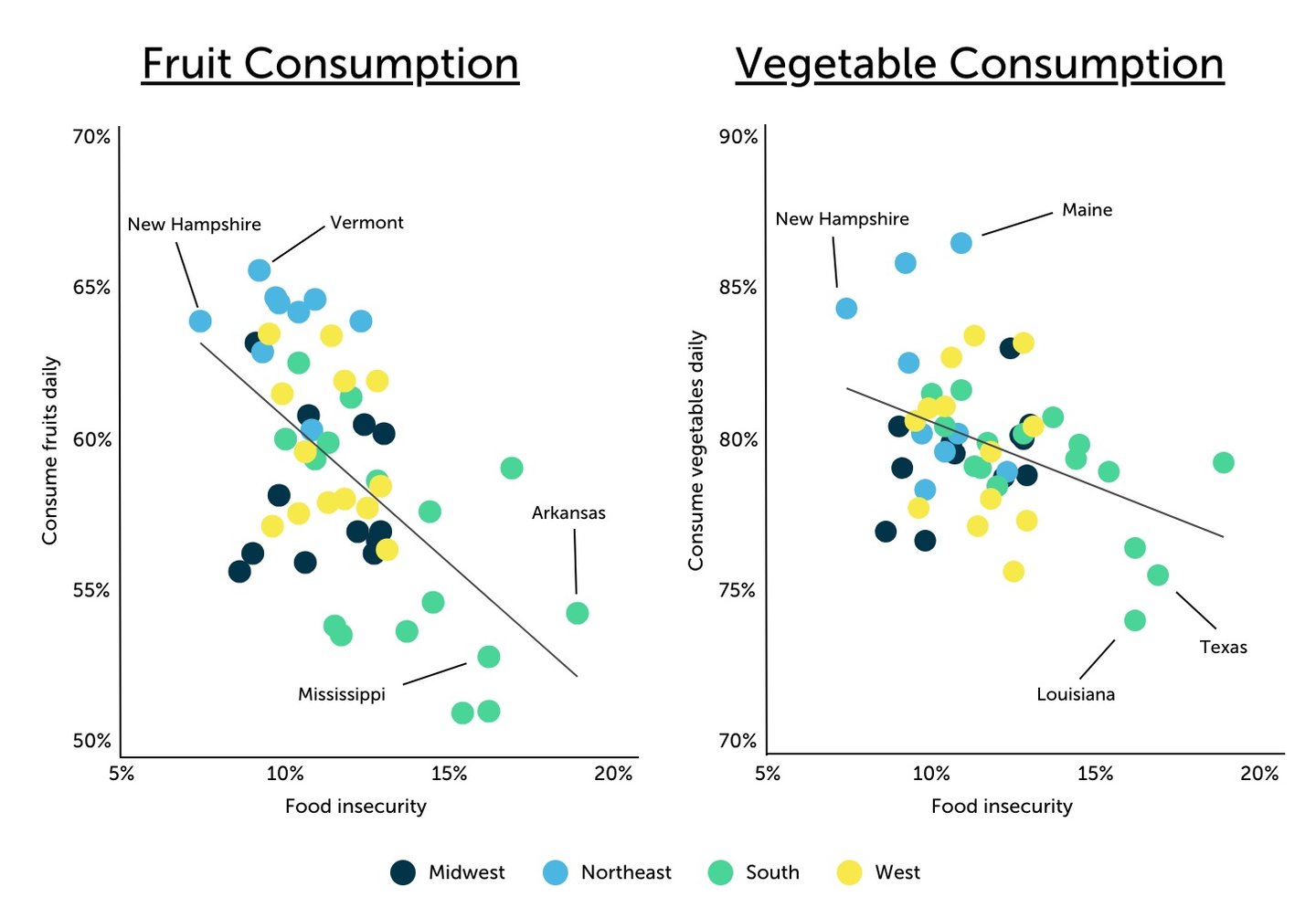Which states have the healthiest diets?
A new study on behalf of Trace One has identified the U.S. states with the healthiest diets.
Trace One notes that obesity is a major public health challenge across the United States, but its impact is most pronounced in Southern and Midwestern states. States like West Virginia (73.2%), Iowa (72.1%) and Louisiana (72.0%) report the highest prevalence of overweight or obese adults. These figures are substantially higher than those observed in states like Colorado (59.8%) and Hawaii (60.5%), which have the lowest rates in the nation.
Similarly, diabetes prevalence, 90–95% of which is Type 2 diabetes—a form largely preventable or manageable through lifestyle changes such as healthier diets and increased physical activity—is significantly higher in the South than in other regions, Trace One said. States like West Virginia (18.2%), Mississippi (17.0%) and Louisiana (16.1%) report the nation’s highest overall diabetes rates. In stark contrast, certain Western states such as Utah (7.8%), Colorado (8.6%) and Alaska (8.7%) have prevalence rates that are about half of those observed in the South.
Similar trends are evident for other diet-related chronic conditions, including high cholesterol, hypertension and cardiovascular disease, where Southern and Midwestern states consistently exceed national averages in prevalence rates. In West Virginia, for instance, the proportion of adults who have experienced either coronary heart disease or a heart attack is approximately 75% higher than the national average.
[Read more: Which states have the cleanest eating habits?]
The same regional patterns that define disparities in chronic health conditions also manifest in food access and dietary habits. Southern and Midwestern states consistently report lower consumption of fruits and vegetables and higher reliance on sugar-sweetened beverages and other processed foods. These dietary habits are influenced by socioeconomic factors, including food insecurity, which is disproportionately prevalent in these regions and significantly impacts the availability and affordability of nutritious options.
Trace One pointed out that food insecurity—defined as lacking consistent access to sufficient food—affects 12.2% of U.S. households, according to the U.S. Department of Agriculture. However, in states like Arkansas (18.9%), Texas (16.9%), Mississippi (16.2%) and Louisiana (16.2%), food insecurity rates far exceed the national average. In these areas, families often turn to cheaper, calorie-dense foods, exacerbating poor dietary habits and limiting the intake of nutrient-rich fruits and vegetables. This dynamic fuels a cycle of poor nutrition, contributing to the region’s elevated rates of diet-related chronic diseases.
In contrast, states with lower levels of food insecurity often report healthier eating patterns. New England states such as Vermont, Maine and New Hampshire consistently lead in fruit and vegetable consumption, with over 64% of adults consuming fruits daily and over 84% eating vegetables daily. These states also report food insecurity rates well below the national average, reflecting how improved access to affordable, nutritious food supports healthier dietary choices.
[Read more: Which states are the happiest?]
When considering eating habits, food access, alcohol consumption and the prevalence of diet-related health conditions, certain states stand out as having the healthiest diets overall.
Leading the nation, Utah achieves its high score due to a combination of strong daily fruit consumption, low rates of alcohol and sugar-sweetened beverage consumption and the lowest rates of diet-related health conditions in the United States. Neighboring Colorado ranks second, driven by its distinction as having the lowest rate of overweight or obesity in the country (59.8%), high fruit and vegetable consumption and low rates of diabetes and other chronic conditions. Additionally, food insecurity in Colorado is among the nation’s lowest, at just 9.9%. Washington, rounding out the top three, performs consistently well across most metrics, including vegetable consumption and low rates of metabolic syndrome, though its slightly higher-than-average alcohol consumption stands out as an area for improvement.
In general, states in the West—particularly the Mountain West—and the Northeast tend to report healthier diets and lower rates of diet-related conditions. Vermont, Massachusetts and Idaho are other top-ranking states in these regions. In stark contrast, states in the South dominate the bottom of the rankings. Of the 10 states with the least healthy diets, nine are in the South, with Louisiana, Arkansas and Mississippi occupying the lowest positions.
Key findings:
- A hefty national expense: According to the CDC, obesity alone costs the U.S. healthcare system nearly $173 billion a year. Diabetes, heart disease and stroke cost an estimated $835 billion in medical costs and lost productivity.
- Paying more, living less: Despite spending $12,555 per capita annually on health care—more than any other country—the United States ranks just 34th in life expectancy worldwide.
- Utah, Colorado and Washington lead with healthiest diets overall: With low rates of diet-related conditions, high fruit consumption and minimal sugar-sweetened beverage intake, Utah tops the rankings. Colorado and Washington follow closely, despite the latter’s higher-than-average alcohol consumption.
- New England states top list for fruit and vegetable intake: Over 64% of adults in these areas consume fruits daily (led by Vermont at 66%), and over 84% eat vegetables daily (led by Maine at nearly 87%). These states also report below-average food insecurity rates.
- Of the 10 states with the least healthy diets, nine are in the South: Louisiana, Arkansas and Mississippi occupy the lowest positions, and also have high rates of food insecurity. In these areas, families often turn to cheaper, calorie-dense options due to a lack of access to nutritious (and affordable) food.
The full report includes Healthy Diet Index scores and 10 key health metrics for all 50 states.
This analysis was conducted by Trace One—a company specializing in software for the food and beverage industry—using data from the CDC and USDA.
Click here for the full report.



